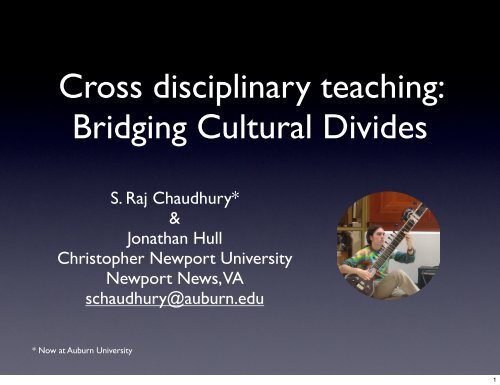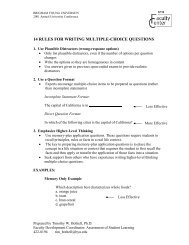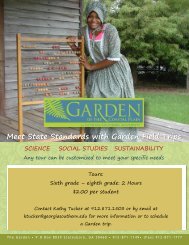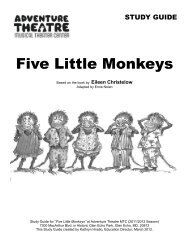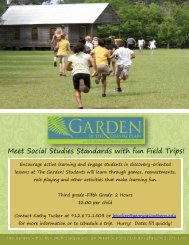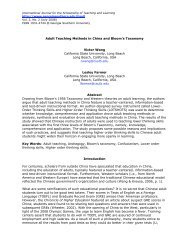S. Raj Chaudhury* & Jonathan Hull Christopher Newport University ...
S. Raj Chaudhury* & Jonathan Hull Christopher Newport University ...
S. Raj Chaudhury* & Jonathan Hull Christopher Newport University ...
You also want an ePaper? Increase the reach of your titles
YUMPU automatically turns print PDFs into web optimized ePapers that Google loves.
Cross disciplinary teaching:<br />
Bridging Cultural Divides<br />
S. <strong>Raj</strong> <strong>Chaudhury*</strong><br />
&<br />
<strong>Jonathan</strong> <strong>Hull</strong><br />
<strong>Christopher</strong> <strong>Newport</strong> <strong>University</strong><br />
* Now at Auburn <strong>University</strong><br />
<strong>Newport</strong> News, VA<br />
schaudhury@auburn.edu<br />
1
What is the name<br />
of the instrument<br />
that was playing as<br />
you entered the<br />
room?<br />
Tanpura<br />
2
Physics & World Music<br />
• NOT about the physics of music (strings,<br />
waves, harmonics, overtones etc.)<br />
• ABOUT the teaching and learning of music<br />
by a physics professor (10+ years)<br />
• ABOUT Catalyst events, Tranformations<br />
and Hybrid pedagogy*<br />
• ABOUT deep engagement by student(s)<br />
* Thanks Kathy<br />
3
Deep Engagement<br />
“Learning to be a full participant in the field”<br />
John Seely Brown<br />
4
Scholarship<br />
“World Music Ensembles: Balancing<br />
Institution, Identity and Improvisation”<br />
<strong>Jonathan</strong> <strong>Hull</strong><br />
MUSC 499, Spring 2008<br />
<strong>Christopher</strong> <strong>Newport</strong> <strong>University</strong><br />
Ethnomusicology thesis<br />
literature review and field work in WMEs<br />
Advisors: Brana Mijatovic, S. <strong>Raj</strong> Chaudhury<br />
5
Learning Sciences<br />
How People Learn (NRC 1999)<br />
(life-slc.org)<br />
• Learning in Informal and Formal Environments<br />
Center (Bransford et. al.)<br />
• How did life-wide learning contribute to course<br />
design, implementation and assessment?<br />
6
London, 1968<br />
7
PHYS 141<br />
MUSC 118<br />
8
Science<br />
•<br />
•<br />
•<br />
•<br />
Compare Pedagogies<br />
Introductory one semester<br />
science course<br />
What are typical goals of<br />
such a class?<br />
What does instruction<br />
look like?<br />
What does assessment<br />
look like?<br />
•<br />
•<br />
•<br />
•<br />
Introductory one semester<br />
Indian music ensemble?<br />
What might be typical<br />
goals of such a class?<br />
What does instruction<br />
look like?<br />
What does assessment<br />
look like?<br />
1 credit course, meets once a week for 2 or 3 hours Music<br />
9
PHYS 141<br />
MUSC 118<br />
10
“The introductory laboratory should<br />
engage each student in significant<br />
experiences with experimental processes<br />
including some experience designing<br />
investigations.” (AAPT, 1997)<br />
11
“The goal of the world music ensemble<br />
should [then] be to cultivate creative<br />
capacities and cultural understanding<br />
through active engagement with and<br />
through the tradition” (J.H., 2008)<br />
12
Tabula Rasa?<br />
Did I have a blank slate to write on?<br />
13
Portal of engagement?<br />
14
Catalyst<br />
• Need for World Music Ensemble instructor<br />
• UCLA connection with Ethnomusicologist<br />
• Music dept. desire to provide in-depth<br />
musical experience as opposed to breadth<br />
• I was there, no extra funds needed<br />
• Cooperative Music & Physics dept. chairs<br />
15
World Music Ensemble, Fall 2007<br />
16
Transformative<br />
• North Indian classical & semi-classical (not<br />
World) at a regional college (low diversity)<br />
• Offered three semesters in a row<br />
• Enrollment 10-12 consistently<br />
• Several ‘repeat’ students<br />
• 3 students took Physics class(es) + Music<br />
• Perform at local cultural events for the<br />
ethnic community (!)<br />
17
What pedagogy to use?<br />
“We teach the way we were taught”<br />
Physics Music<br />
“Performance is the crux of the<br />
world music ensemble.<br />
Playing the music is what attracts people<br />
not just learning about it.”<br />
J.H., 2008<br />
18
Apply my Physics pedagogy<br />
• Active Learning<br />
• Formative Assessment<br />
to Music?<br />
... or create a new Hybrid pedagogy?<br />
19
Hybrid Pedagogy<br />
Tabla<br />
Harmonium<br />
20
Limits on the pedagogy<br />
• <strong>University</strong> had no instruments (self)<br />
• Use voice as the medium for instruction<br />
• Instructor<br />
• No degrees or formal coursework in<br />
music (how to satisfy SAACS?)<br />
• No knowledge of Western classical music<br />
• Students<br />
• No auditions to encourage enrollment<br />
• No ethnic Indians; no language courses<br />
21
Assessment<br />
• Typical science class<br />
• Quizzes, tests, lab reports<br />
• Active Learning science class<br />
• Presentations, group work<br />
• World Music Ensemble - PERFORMANCE<br />
22
UCLA Indian Music Performance Group<br />
1986<br />
23
CNU World Music Ensemble<br />
Fall 2007<br />
24
Measures of success?<br />
• Science class<br />
• Student performance on tests etc.<br />
• Music Ensemble<br />
• <strong>University</strong> based experts not available<br />
• Depend on ethnic community<br />
• Performed at Hindu Temple<br />
25
Making Thinking Visible<br />
...full participant in the field?<br />
26
Improvisation & Surprise<br />
27
“I had to use my ears and emotions more to fully<br />
encompass the meaning of the music rather than focus<br />
on meticulous details that I feel now kept me from fully<br />
developing musically” - Student in J.H. 2008<br />
28
Student voices<br />
“The hardest challenge for me was breaking myself<br />
of my trained perspective of music, with this new<br />
perspective. One needs an open and accepting mind,<br />
clear of conventions”.<br />
“At first I tried to apply my former understanding of<br />
music to understanding Indian music. You simply<br />
cannot do that. Indian music works under a<br />
completely different paradigm of thought...”<br />
29
Improvisation Index<br />
Tabula Rasa?<br />
Ethnomusicology Student<br />
Non-ethno student w/o prior Western<br />
Non-ethno student<br />
w/prior Western<br />
30
•<br />
•<br />
•<br />
•<br />
Final thoughts<br />
“To understand and acquire the new system<br />
required problem solving and restructuring of<br />
abstract conceptual processes”<br />
“... it is in experiencing the collisions and problems<br />
that growth from one’s own tradition leads to<br />
growth towards another”.<br />
Cognitive Dissonance & Conceptual Change!!<br />
Goals in Physics & Music could be the same!<br />
31
Acknowledgements<br />
• Students of the WME (07-08)<br />
• Mark Reimer, Brana Mijatovic, CNU Music<br />
Dept.<br />
• The Indian community of Hampton Roads<br />
• Biggio Center, Auburn <strong>University</strong><br />
32


